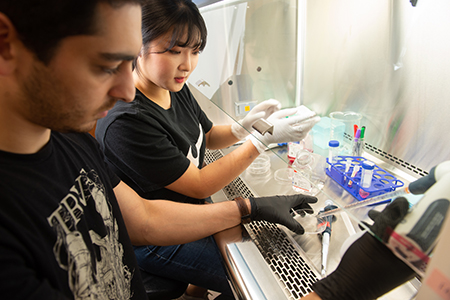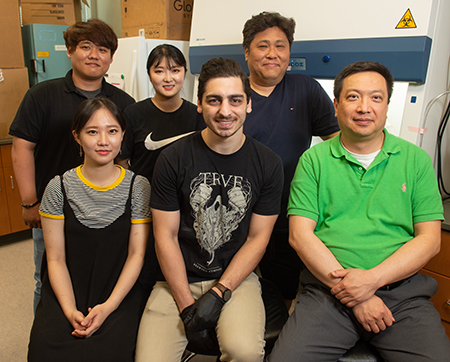SIUE Researcher Collaborates with South Korean Team to Validate Non-Animal Screening Model for Hazardous Chemicals
 While student activity is quieter on campus through the summer months, faculty research continues full swing at Southern Illinois University Edwardsville. This summer, the lab of Kyong Sup Yoon, PhD, assistant professor in the Department of Environmental Sciences, was bustling with important activity as he hosted colleagues from South Korea’s Dongguk University.
While student activity is quieter on campus through the summer months, faculty research continues full swing at Southern Illinois University Edwardsville. This summer, the lab of Kyong Sup Yoon, PhD, assistant professor in the Department of Environmental Sciences, was bustling with important activity as he hosted colleagues from South Korea’s Dongguk University.
It marked the second of a three-summer visit during which Yoon and his graduate students are validating a newly developed Organization for Economic Co-operation and Development (OECD) official non-animal testing method for the detection of hazardous chemicals, including endocrine disrupting chemicals (EDCs). The project is led by principal investigator Yooheon Park, PhD, of Dongguk University.
“Dr. Park is a food scientist, and I’m a toxicologist, making this collaboration a perfect fit,” Yoon said. “Dr. Park is developing a non-animal screening method. He’s developing a method using cell cultures that are genetically transformed to detect chemicals by bioluminescence. My team is validating that method.”
 “The OECD has a set of strict rules for developing a new standardized method to detect environmental chemicals, including various EDCs,” Park explained. “It is obvious that the method should be suitable for member countries to use and ensure test results can be shared without further treatments. Validation of a newly developed method, therefore, is an important part of the current project to gain international support and acceptance of the method that can be used for hazard identification and risk assessment.”
“The OECD has a set of strict rules for developing a new standardized method to detect environmental chemicals, including various EDCs,” Park explained. “It is obvious that the method should be suitable for member countries to use and ensure test results can be shared without further treatments. Validation of a newly developed method, therefore, is an important part of the current project to gain international support and acceptance of the method that can be used for hazard identification and risk assessment.”
“According to the OECD guidance, the validation should be done in a Good Laboratory Practice (GLP) or equivalent laboratory,” Park added. “I strongly believe that Dr. Yoon’s research team and his laboratory in the Department of Environmental Sciences are highly qualified and capable of validating our method.”
While Yoon acknowledges this new model will likely not completely replace screening methods using animals, it is a noteworthy step toward reducing usage.
“The animal model is vital in any research field,” Yoon said. “But, without putting effort to reduce the usage, we’ll continuously be depending on this animal model for our medical or biological research. We want to show that certain things can be done in a standardized way, without using the animal model.”
Park notes his research group is working with South Korea’s National Institute of Food and Drug Safety Evaluation (NIFDS). Development of this new method aligns with Dongguk University’s values as a Buddhist-affiliated university.
“My current research to develop a non-animal test method reflects one of the Buddhist teachings: Do no harm to all living creatures,” Park said. “Once developed, our method, accompanied with a detailed Test Guideline, will be used by many government, industry, and independent laboratories to identify hazard and/or determine the safety of chemicals. This will promote the generation of dependable data for human and animal health, and environmental risk assessments”
Following next summer’s completion of the validation process, Yoon and Park hope to pursue new projects that will produce synergic outputs through their institutional collaboration.
Photos: Student researchers Hyeyeoung Seo (Dongguk University) and Carl Namini (SIUE) prepare cell cultures for detection of endocrine disrupting chemicals.
Visiting SIUE from South Korea’s Dongguk University were (back L-R) Dr. Seokhee Lee, Hyeyeoung Seo, Dr. Yooheon Park, and (front L-R) Hyemi Kim. Sitting alongside the research team are SIUE graduate student Carl Namini and Dr. Kyong Sup Yoon.










